Small Trees for Backyards (With Pictures) – Identification Guide
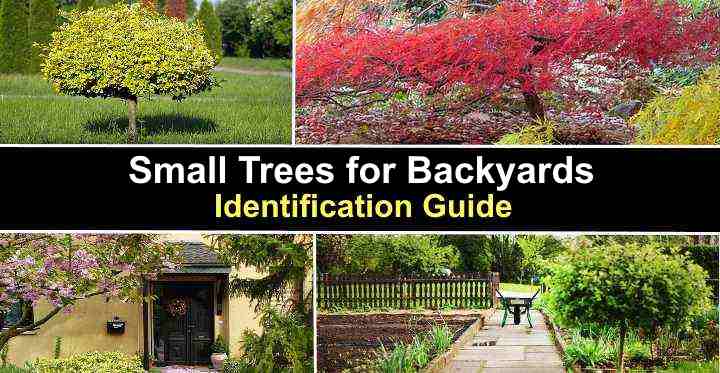
Small trees are an essential addition to a backyard landscape. Growing small trees under 20 feet (6 m) tall is ideal for providing shade, protection, color, and beauty to your property. Many small flowering trees have spectacular fragrant blossoms that enhance your property’s aesthetics. Or, you could plant small evergreen trees to enjoy year-long color in an otherwise barren landscape.
When it comes to choosing small trees to plant in your backyard, there are many to select from. For example, dwarf weeping trees provide a visual focal point in a lawn or flowerbed. Or small decorative trees are ideal for adding beautiful foliage and texture to your property. Additionally, small evergreen trees planted in a row create an effective noise barrier or privacy screen.
This article provides information on selecting the right type of small tree to grow in a backyard. Descriptions and photos of popular ornamental dwarf trees and small types of trees will help you make an informed decision.
How to Select Small Trees for Backyard Landscaping
To choose the perfect low-growing decorative tree for a backyard, consider its size, spread, and ease of care. Additionally, you should think about the growing zone, the type of soil, and how much sun your backyard gets during the day. Finally, the foliage color and bloom time can help you choose a small tree for your yard.
All the trees on this list don’t grow taller than 20 ft. (6 m) in height. However, even for the smallest backyards, this could be considered too tall. Additionally, you will also find ornamental trees that only grow a few feet tall, so it’s important to consider the height of the mature tree.
Small Trees for Backyards (With Pictures): Identification Guide
Let’s look in more detail at some of the best small ornamental backyard trees.
Dwarf Weeping Cherry Trees
Dwarf weeping cherry trees are compact trees that are a perfect choice for backyard landscaping. They are slow-growing deciduous trees that produce beautiful white or pink fragrant flowers in early spring. Their glossy dark green leaves grow on cascading branches, turning shades of gold, red, orange, and bronze in the fall. Depending on the species, dwarf weeping cherry trees grow 6 to 15 ft. (1.8 – 4.5 m) tall.
The weeping cherry trees are ideal for planting in sunny locations in a front or backyard.
Here are a few of the most spectacular dwarf weeping cherry trees for compact backyards:
Japanese Flowering Dwarf Weeping Cherry Tree (Prunus serrulata ‘Kiku-Shidare-Zakura’)—Also called sakura, this eye-catching small tree has pink blossoms with double ruffled petals flowering on cascading branches. It grows 10 to 15 ft. (3 – 4.5 m) tall.
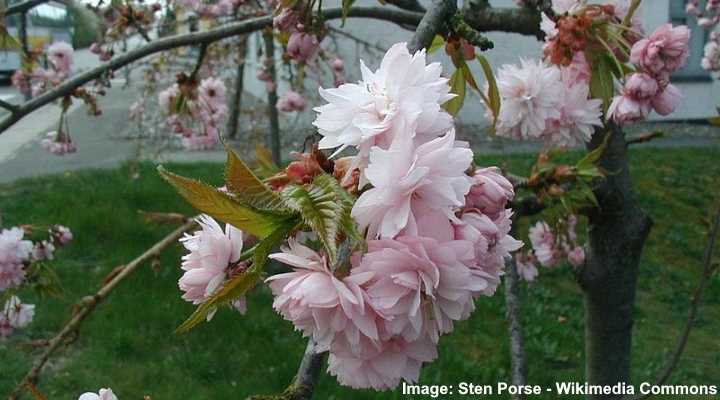
Japanese Flowering Dwarf Weeping Cherry Tree (Prunus serrulata ‘Kiku-Shidare-Zakura’)
Hiromi dwarf weeping cherry tree (Prunus jacquemontii ‘Hiromi’)—This miniature ornamental weeping tree grows 3 to 6 ft. (1 – 1.8 m) tall. Its decorative value comes from its masses of fragrant pink flowers covering arching branches that almost reach the ground.
Snow Fountain dwarf weeping cherry tree (Prunus serrulata ‘Snow Fountain’)—The white-flowering decorative weeping cherry tree has a rounded canopy and stunning pure white, bright flowers. It grows 8 to 15 ft. (2.4 – 4.5 m) tall and 6 to 8 ft. (1.8 – 2.4 m) wide.

Snow Fountain dwarf weeping cherry tree (Prunus serrulata ‘Snow Fountain’)
Growing conditions: Full sun or light shade in organically-rich, well-drained soils.
Size: 3 to 15 ft. (1 – 4.5 m) tall and up to 15 ft. (4.5 m) wide.
Zones: 4 to 9.
Weeping Eastern Redbuds (Cercis canadensis ‘Ruby Falls’ and ‘Lavender Twist’)
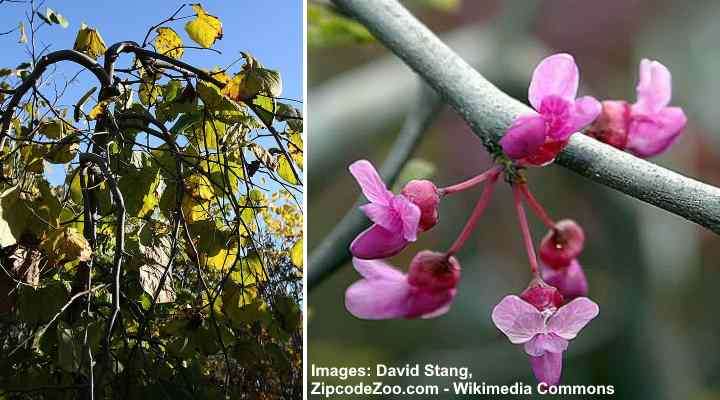
Images of Eastern redbud ‘Lavender Twist’ (also called ‘Covey’) which is a dwarf weeping cultivar of Eastern redbud tree that is great for compact front or backyard
Several species of redbud trees have a weeping habit and beautiful flowers, making them ideal trees for backyards. These ornamental dwarf weeping trees are identified by their early spring flowers blooming on bare branches. The weeping redbuds have small heart-shaped leaves and dainty pink or pink-purple flowers.
These dwarf ornamental trees are spectacular landscaping plants with attractive clusters of flowers for a small-scale backyard.
Growing conditions: Full sun or light shade in organically-rich, well-drained soils.
Size: 5 to 6 ft. (1.5 – 1.8 m) tall and 3 to 4 ft. (1 – 1.2 m) wide.
Zones: 5 to 9.
Weeping Mulberry (Morus alba ‘Chaparral’)
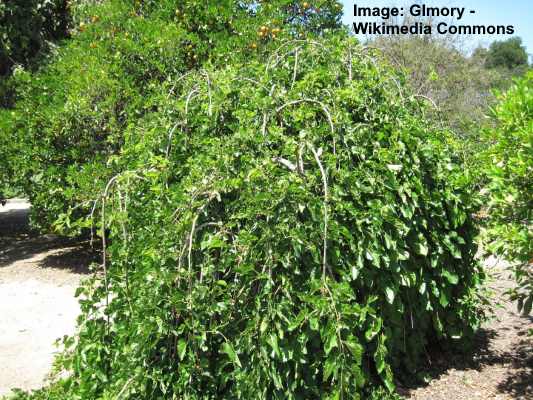
‘Chaparral’ cultivar is a type of dwarf weeping mulberry that is suitable for landscaping small backyards
The weeping mulberry ‘Chaparral’ is a small ornamental tree with arching branches covered in glossy green foliage. The decorative features of this white mulberry cultivar are its yellowish-green flowers, blackberry-like edible fruit, and cascading branches that weep to the ground. This heat and drought-tolerant tree has shallow roots and grows in a wide range of soils.
Growing conditions: Full sun or partial shade in fertile, well-draining soils.
Size: 6 to 8 ft. (1.8 – 2.4 m) tall and 8 to 12 ft. (2.4 – 3.6 m) wide.
Zones: 4 to 8
Weeping Crabapple (Malus ‘Louisa’)

The weeping crabapple is a low maintenance decorative small tree with attractive pink flowers
The weeping crabapple is a beautiful ornamental fruit tree famed for its red flower buds and breathtaking pink flowers. After flowering, the droopy tree produces small yellowish-red apples that persist through fall until winter. With its cascading branches and attractive flowers, this tree attracts bees and early spring pollinators.
Weeping crabapples are excellent trees for landscaping a backyard where space is limited. However, when the small crab apples drop, the trees can become somewhat messy in winter.
Growing conditions: Full sun or light shade in organically-rich ground, and the soil needs to have good drainage.
Size: 12 to 15 ft. (3.6 – 4.5 m) tall and wide.
Zones: 4 to 8.
Small Flowering Trees For Backyards (With Pictures)
If you are looking for beautiful flowering trees for landscaping a compact backyard, then please continue reading. You will find stunning trees that don’t grow very tall — ideal if you don’t have much room in your backyard.
Sargent Crabapple (Malus sargentii)
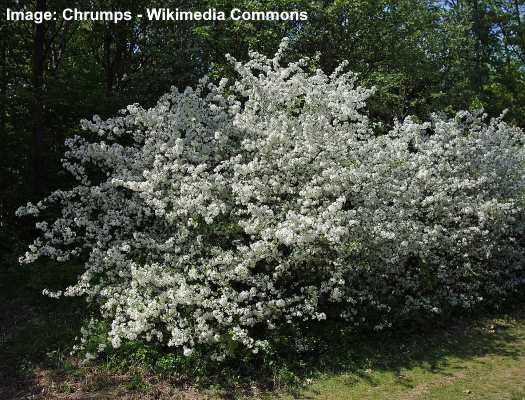
Sargent crabapple is an attractive white flowering tree that is suitable for small backyards
The crabapple dwarf cultivar ‘Sargent’ is a small flowering tree well suited to growing in a compact backyard. The small white-flowering tree is identified by its small dainty blossoms, dense, lush green foliage, and zigzagging branches. In addition, this crabapple tree is a small ornamental fruit tree that produces tiny cherry-sized apples.
Sargent crabapple has a spreading crown covered in dense foliage. In addition to having white flowers and attractive foliage, the leaves turn golden yellow in the fall, adding to its charm.
Growing conditions: Full sun in moderately moist, organically-rich, well-drained soils.
Size: 6 to 10 ft. (1.8 – 3 m) tall and 6 to 12 ft. (1.8 — 3.6 m) wide.
Zones: 5 to 9.
Small Magnolia Trees
Many species of magnolia trees are small ornamental trees that can add a pop of color to your backyard, producing pink, purple, white, and yellow flowers. Backyard magnolias have large, showy cup- or star-shaped flowers, glossy green, leathery leaves, and small cone-like fruits. The small, beautiful trees or multi-stemmed shrubs are perfect for planting in small-scale backyards.
Here are a couple of landscaping ideas for growing magnolias in a garden:
Star Magnolia Small Flowering Tree (Magnolia stellata)—This short deciduous tree has star-shaped white blossoms and ovate leaves. It grows up to 6 ft. (1.8 m) tall.
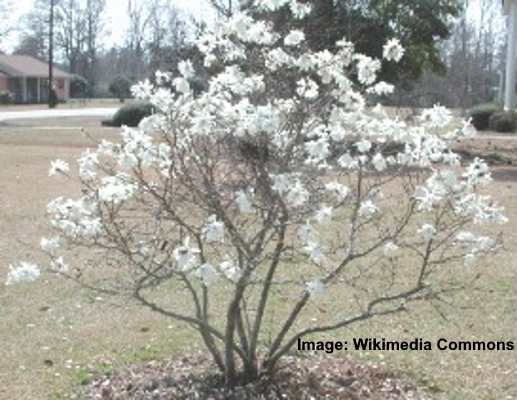
Star Magnolia (Magnolia stellata)
Jane Magnolia (Magnolia liliiflora x Magnolia stellata)—This attractive small magnolia tree or shrub has large purple and white tulip-like flowers that measure 8” (20 cm). The dwarf flowering tree grows 10 to 15 ft. (3 – 4.5 m) tall and 6.5 ft. (2 m) wide.
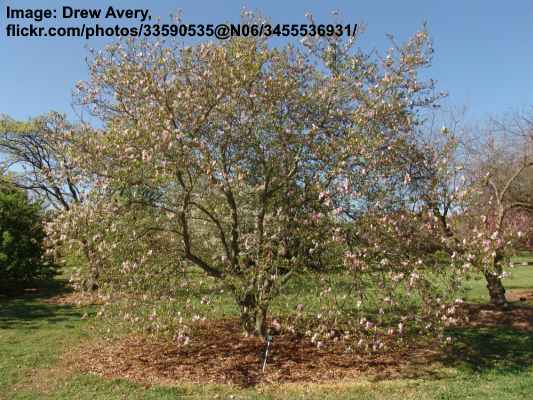
Jane Magnolia (Magnolia liliiflora x Magnolia stellata)
Growing conditions: Full sun or partial shade in slightly acidic, fertile soils with excellent drainage.
Size: 8 to 20 ft. (2.4 – 6 m) tall and up to 6 to 12 ft. (1.8 – 3.6 m) wide.
Zones: 5 to 9.
Small Flowering Crape Myrtle Trees
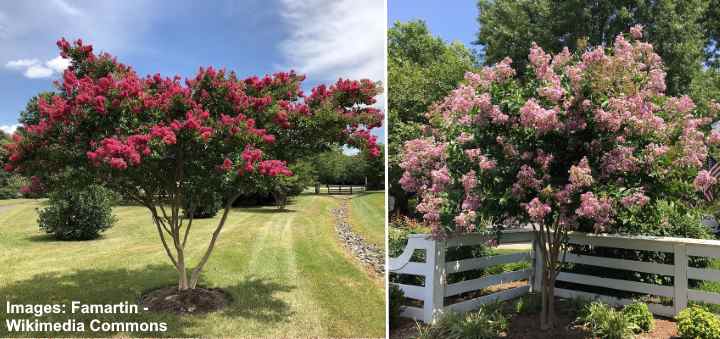
Crape myrtle are shrub-like trees with multiple stems and many small cultivars are excellent for compact backyards
Several varieties of crape myrtle trees are dwarf or miniature trees ideal for planting in the smallest of backyards. The small shrub-like trees are renowned for their showy flower clusters in vibrant reds, pinks, white, and purples. The explosion of colorful blossoms persists from midsummer through to late fall.
Apart from landscaping a backyard, small crape myrtle trees are ideal for growing as a foundation plant, colorful screen, or informal hedge.
Growing conditions: Full sun in soils with average moisture and nutrient content.
Size: 3 to 15 ft. (1 – 4.5 m) tall and 3 to 6 ft. (1 – 1.8 m) wide, depending on the cultivar.
Zones: 6 to 9.
Related reading: How to care for crape myrtle ornamental trees.
Dwarf Serviceberry (Amelanchier ‘La Paloma’)
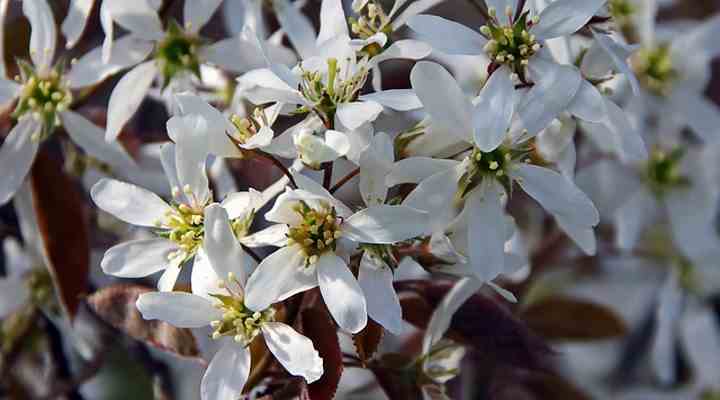
The white flowers of the dwarf serviceberry tree gives ornamental value to compact gardens
Suitable for a small-scale backyard, the ‘La Paloma’ serviceberry is a white-flowering small tree with shrub-like growth. The attractive ornamental tree has fragrant white blossoms, red or purple berries, and brilliant fall colors of orange and red. Its attractive branching shape and light gray bark give the tree year-round interest.
You can plant this dwarf serviceberry at the back of your house as a hedge, screen, specimen plant for small backyards, or lawn tree.
Growing conditions: Full sun or part shade in moist, well-drained, organically-rich soils.
Size: 8 to 15 ft. (2.4 – 4.5 m) tall and wide.
Zones: 4 to 8.
Small Redbud Trees
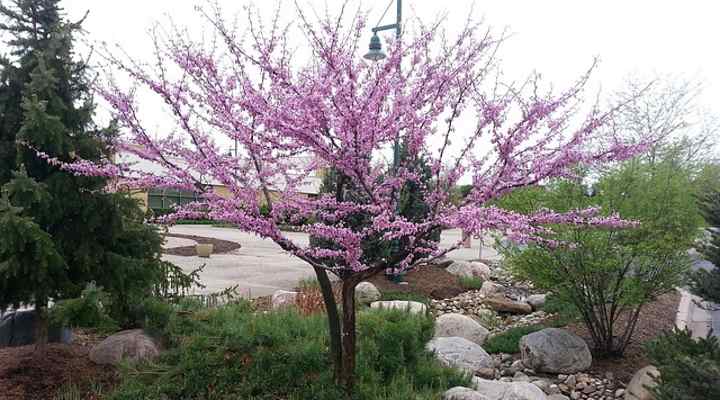
The small Eastern redbud tree is a beautiful flowering tree that will enhance any small backyard
Many flowering redbud trees don’t grow over 12 ft. (3.6 m) tall and are perfect for backyard planting. The small deciduous tree is covered in vibrant pink, red, or purple pea-like flowers in spring. These color displays brighten spring gardens for several weeks. After flowering, the ornamental tree produces heart-shaped leaves that develop rich fall colors before they drop.
Growing conditions: Full sunlight or light shade in moderately fertile, well-drained soils.
Size: 5 to 20 ft. (1.5 – 6 m) tall and 15 ft. to 25 ft. (4.5 – 7.6 m) wide.
Zones: 5 to 9.
Small Decorative Backyard Trees
Small decorative trees are the perfect landscaping solution for backyard landscapes to add texture, height, and color. Here are several decorative trees with limited height that are perfect for any garden or patio.
Small Japanese Maple ‘Shaina’ (Acer palmatum ‘Shaina’)

Shaina Japanese maples are stunning dwarf trees that are perfect for containers or compact backyard spaces
The dwarf Japanese maple ‘Shaina’ is small enough to grow as a lawn tree in a compact garden space. This dwarf variety has branches that form a rounded crown. The ornamental appeal of this low-growing maple tree is its maroon and deep red, lobed, palmate leaves with toothed edges. The tree’s slightly cascading branching habit makes it perfect for compact spaces.
There are other types of dwarf Japanese maples you can plant in a backyard.
Growing conditions: Full sun or light shade in organically-rich, well-drained soils.
Size: 4 to 6 ft. (1.2 – 1.8 m) tall and 4 ft. (1.2 m) wide.
Zones: 5 to 9.
Red Buckeye (Aesculus pavia)
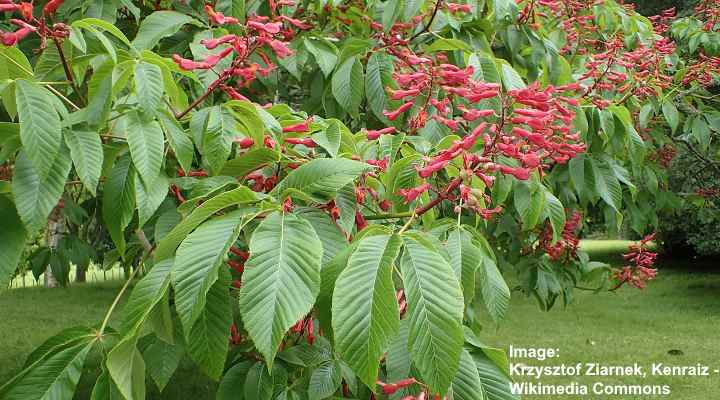
The red buckeye is a small ornamental tree with reddish-pink flowers, suitable for front or backyards
The red buckeye is a fantastic addition to a backyard landscape due to its short stature, huge flower clusters, and large decorative leaves. This small landscaping tree has conical red flower clusters in spring and produces shiny brown nuts in the fall. In addition, the large leafy foliage makes the red buckeye an excellent shade tree.
Use the red buckeye in landscaping as a flowering tree, hedge, or specimen plant.
Growing conditions: Full sun or partial shade in moist, fertile soils that drain well.
Size: 12 to 15 ft. (3.6 – 4.5 m) tall and wide.
Zones: 4 to 8.
Plumeria Tree (Frangipani)
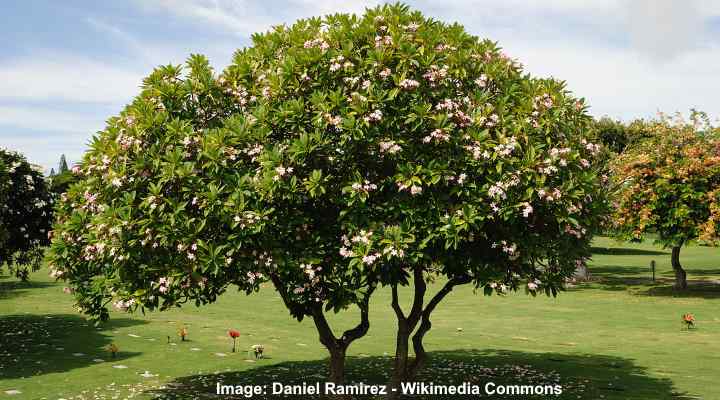
The small plumeria tree is suitable for landscaping tropical and subtropical garden landscapes
Also called the frangipani tree, small plumeria trees are a popular choice for landscaping backyards with trees in the southern states. Identifying features of the plumeria tree are its exotic, tropical, sweetly-scented flowers, bright colors, and large spatula-shaped leaves. Blooms on plumeria trees can be yellow, pink, white, or multi-colored petals.
Several varieties of plumeria trees that grow less than 20 ft. (6 m) are cultivars of the species Plumeria rubra.
Growing conditions: Full sun in dry to medium moist, well-drained soils.
Size: 10 to 20 ft. (3 – 6 m) tall and 8 to 10 ft. (2.4 – 3 m) wide.
Zones: 10 to 12.
Roughleaf Dogwood (Cornus drummondii)
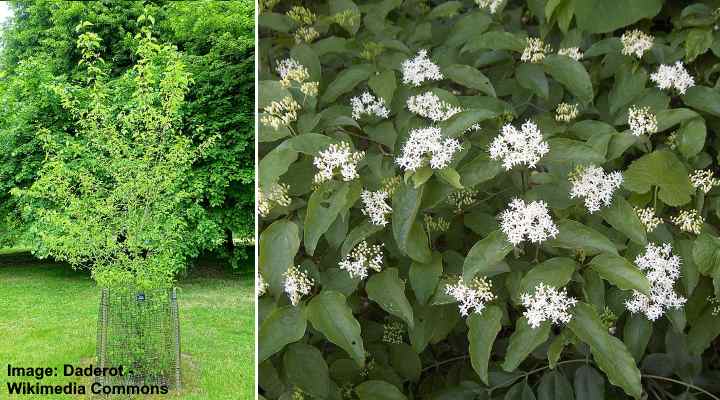
Roughleaf dogwood young tree (left), leaves and flowers (right)
Roughleaf dogwood is a decorative tree suitable for a small-scale backyard. Ornamental features of this small tree are its clusters of flat-topped creamy-white flowers, large elliptic to oval leaves, and white berries in late summer. The tree’s foliage has a distinct rough texture on the upper side and a velvety underside.
The roughleaf dogwood tree species is ideal for growing in sunny backyards as an informal screen, privacy hedge, or windbreak. In addition, its tolerance for damp soil makes it suitable for planting near ponds.
Growing conditions: Full sunlight or partial shade in medium, moist, to wet soils.
Size: 6 to 15 ft. (1.8 – 4.5 m) tall and wide.
Zones: 5 to 8.
Small Evergreen Backyard Trees (With Pictures)
Many compact, small backyard landscapes benefit from planting evergreen trees. Conifers and other trees that keep their foliage are a perfect choice for privacy, shade, and green color throughout the year.
Irish Yew ‘Fastigiata’ (Taxus baccata ‘Fastigiata’)
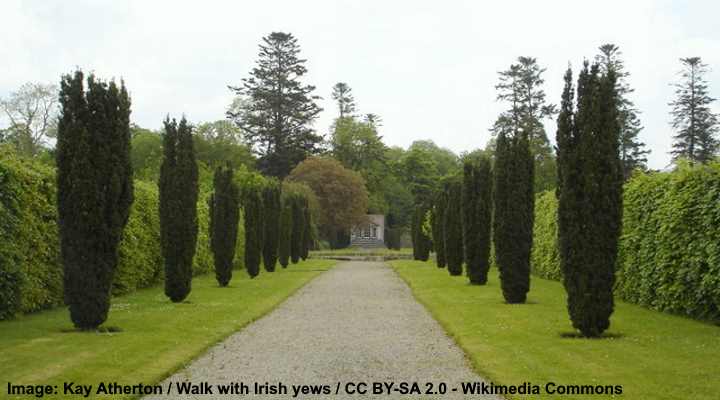
The small columnar Irish yew doesn’t take up much space in small spaces or compact backyards
The Irish yew ‘Fastigiata’ is one of the most popular dwarf evergreen trees for planting in a garden at the rear of a property. The slow-growing coniferous tree has a columnar growth habit, making it an ideal choice for tight spaces. The evergreen foliage consists of needle-like leaves, and red berry-like fruits appear in summer.
Landscaping ideas for growing an Irish yew include mass planting for a privacy hedge, foundation planting, or as a vertical accent tree in a compact backyard.
Check out some attractive yew shrubs for landscaping.
Growing conditions: Full sun or light shade in organically-rich, well-drained soils.
Size: 3 to 15 ft. (1 – 4.5 m) tall and up to 15 ft. (4.5 m) wide.
Zones: 4 to 9.
Sky Pencil Holly (Ilex crenata ‘Sky Pencil’)
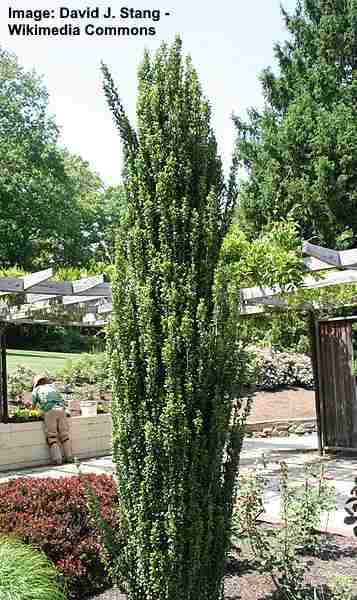
Sky Pencil Holly has a narrow growth habit and is not too tall
The Sky Pencil holly is a small evergreen tree with narrow growth, making it an excellent choice for space-restricted backyards. This holly species has glossy evergreen foliage on upward-pointing branches, tiny white flowers, and black berry-like fruits. The Japanese holly is a slow-growing tree and easy to care for in a partially sunny landscape.
You can plant the Sky Pencil holly as a screen, hedge, specimen tree, foundation plant, or wall-side border.
Growing conditions: Full sun or light shade in moist soil with good drainage.
Size: 6 to 10 ft. (1.8 – 3 m) tall and up to 3 ft. (1 m) wide.
Zones: 6 to 8.
Dwarf Pencil Point Juniper (Juniperus communis ‘Compressa’)
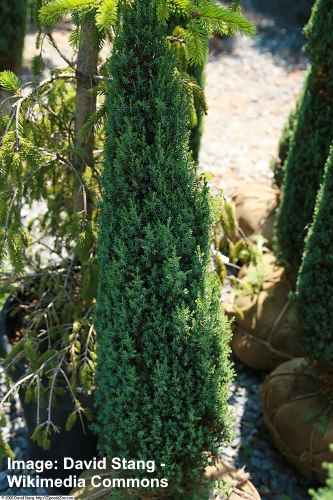
The dwarf pencil point juniper is a great tree for narrow spaces in your garden
The Pencil Point juniper is one of the smallest dwarf trees with evergreen foliage. This short, columnar tree only grows a few feet tall, making it well-suited for the smallest yards. The attractive features of this juniper tree are its blue-green needle like leaves that turn a coppery-green color in the fall.
The columnar shape of the conifer means it’s perfect for planting in tight spaces. It also grows well as an accent plant, at the corner of the house, or in a container to add greenery to a patio in cooler climates.
Growing conditions: Easy to grow in full sun and well-draining soils with moderate moisture.
Size: 2 to 3 ft. (0.6 – 1 m) tall and 1 to 2 ft. (0.3 – 0.6 m) wide.
Zones: 2 to 6.
Check out some other beautiful dwarf evergreen conifers that provide year-long decorative value in garden landscapes.
Other Small Backyard Trees
Fringe Tree (Chionanthus virginicus)

The compact fringe tree is a popular choice for backyards because of its beautiful, fragrant white flowers that bloom in spring. The flowers have narrow, elongated petals, which give them a unique fringe-like appearance. The tree also has wide, dark-green, lance-shaped leaves, that beautifully contrast against the white blooms. It also showcases spreading branches, adding to its decorative appeal in backyards.
Fringe trees grow 12 to 20 ft. (3.6 – 6 m) tall and wide, making them perfect in size for small backyards. For optimal growth, plant in USDA zones 3 to 9 in full sun or partial shade. They perform well in moist, well-drained soils. These trees don’t perform well in drought conditions and salt spray. Some landscaping ideas include planting as a specimen plant, shade tree, or accent tree in your backyard.
An ornamental aspect of fringe trees is when the petals fall and create a white, snow-like blanket on the ground beneath the tree.
Growing conditions: Full sun or partial shade
Size: 12 to 20 ft. (3.6 – 6 m) tall and wide
Zones: 3 to 9
Fernleaf Full Moon Maple Tree (Acer japonicum ‘Aconitifolium’)
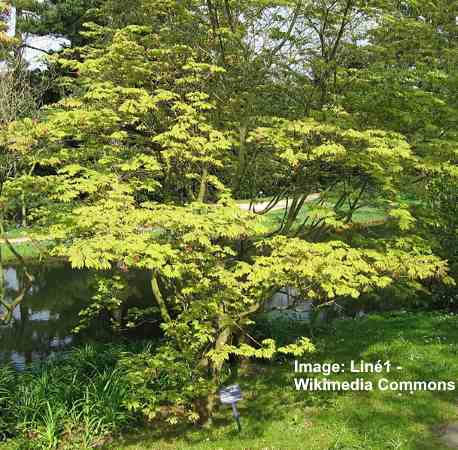
If you’re looking for a small ornamental tree for your backyard, consider the fernleaf full moon maple. This beautiful tree is known for its attractive leaves that transition into beautiful shades of red or scarlet in autumn. The ornamental leaves are fern-like, palmate, and mid-green in color. Some other identifying features of this tree include its clusters of tiny red flowers, winged maple seeds, and dense, upright branching habit.
The Japanese maple ‘Aconitifolium’ reaches a height and width of 8 to 10 ft. (2.4 – 3 m). This low-maintenance tree is ideal for planting in small backyards as an accent tree or individual focal point. It’s the perfect choice for adding some brilliant color and texture to your backyard in autumn. Make sure to plant in moist, organically rich, well-draining soils for optimal results.
Growing conditions: Full sun to partial shade
Size: 8 to 10 ft. (2.4 – 3 m)
Zones: 5 to 7
Purple Leaf Sand Cherry (Prunus × cistena)
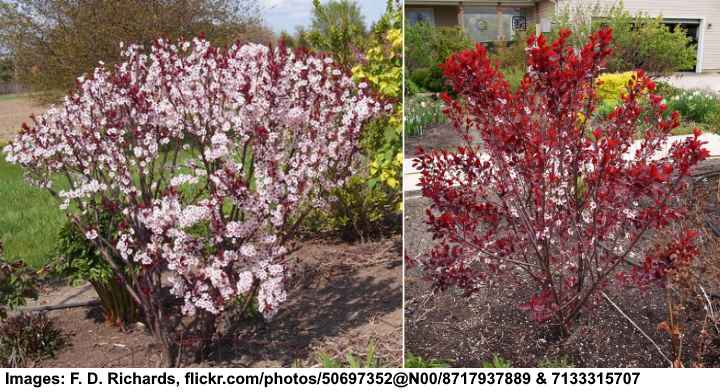
The purple-leaf sand cherry is a small ornamental tree or deciduous shrub known for its clusters of small, pale-pink or white flowers. These flowers are highly-fragrant, attracting pollinators such as butterflies and bees. This decorative tree also has pretty purple-red leaves, fragrant pale pink flowers, and an upright growth habit.
Growing up to 6 to 10 ft. (1.8 – 3 m) tall and wide, they are perfect in size for small backyards. Purple-leaf sand cherry trees are extremely versatile and ideal for planting as a decorative shrub, hedge, specimen plant, or small focal point. For optimal growth, plant these trees in full sun and well-draining soil in USDA zones 2 to 8.
Growing conditions: Full sun
Size: 6 to 10 ft. (1.8 – 3 m)
Zones: 2 to 8
Pygmy Date Palm (Phoenix roebelenii)
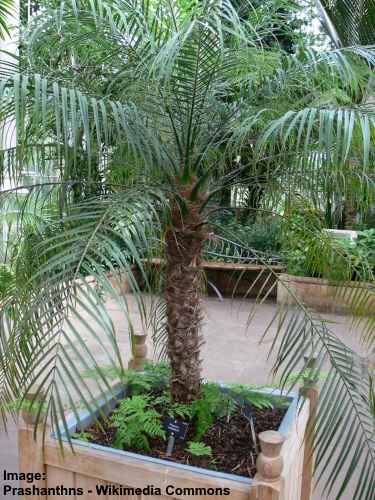
The pygmy date palm is an attractive, small, subtropical palm tree known for its beautiful, arching, feather-like fronds that measure up to 3 ft. (1 m) long. If you want to add a tropical touch to your backyard, consider growing the pygmy date palm. Other identifying features include creamy-yellow flowers and red-black, edible fruits that resemble dates.
The pygmy date palm grows 6 to 10 ft. (1.8 – 3 m) tall and is cold-hardy down to 26°F (-3°C). Its compact size makes it a perfect palm tree for small backyards or front gardens. Additionally, it is well-suited for container planting, making it a great selection for enhancing patios and courtyards.
Growing conditions: Full sun to partial shade
Size: 6 to 10 ft. (1.8 – 3 m)
Zones: 9 to 11
Summer Chocolate Mimosa Tree (Albizia julibrissin ‘Summer Chocolate’)
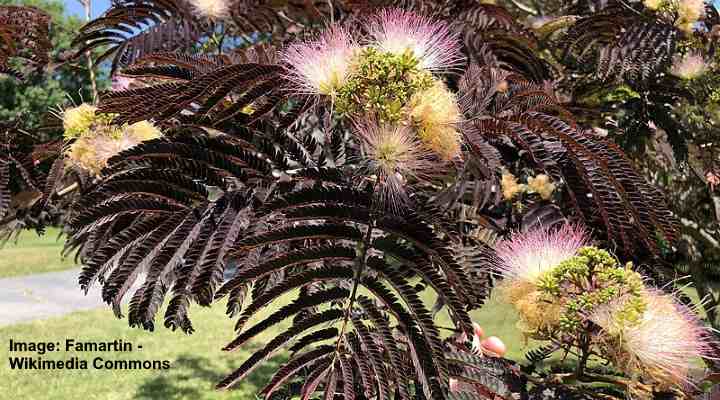
With its beautiful fluffy pink-white flowers and small size, the chocolate mimosa tree is a perfect choice for tight backyards. Some ornamental features of this small landscaping tree are its pincushion-like flowers, deep purple bipinnate leaves, and long, flat seed pods.
The highly scentful pink-white flowers create a beautiful contrast against the deep purple foliage. Grow this tree in moist, well-drained soil in full sun for the best results. This fast-growing tree grows 15 to 20 ft. (4.5 – 6 m) tall and wide, making it an ideal choice for adding some visual interest to your small backyard.
Growing conditions: Full sun
Size: 15 to 20 ft. (4.5 – 6 m) tall and wide
Zones: 6 to 9
Small Ornamental Chaste Tree (Vitex agnus-castus)

Growing the compact chaste tree in your small yard will provide color, beauty, and delightful fragrances. This shrubby tree is known for its clusters of sweet-smelling purple or blue-violet flowers that blossom at the end of summer. Commonly referred to as the monk’s pepper, this deciduous tree features palmately compound grayish-green leaves, pink, white, or lavender flower clusters, and rounded fruits in the fall.
The chaste tree can grow up to 8 to 10 ft. (1.8 – 3 m) tall. It can also withstand drought conditions, working well in cottage gardens, mixed borders, and even xeric landscapes. This tree makes a perfect specimen plant, foundation plant, or standalone focal point in your backyard.
Growing conditions: Full sun
Size: 8 to 10 ft. (1.8 – 3 m)
Zones: 7 to 9
Japanese Flowering Quince (Chaenomeles Japonica)
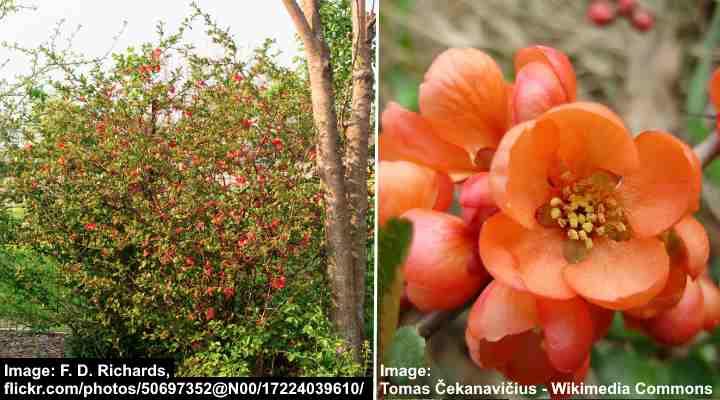
The Japanese flowering quince is a small tree with shrub-like growth that is a great choice for smaller yards. It is characterized by its beautiful clusters of five-petaled, bright orange or scarlet, cup-shaped flowers with yellow stamens. The rounded canopy of the tree enhances its charm and elegance. When the blossoms fall off, the tree grows round, apple-like fruits ranging in color from golden-yellow to light green. Additionally, the leaves are lanceolate in shape, shiny, and have a hue of medium green.
For optimal growth, plant the Japanese flowering quince in well-drained soil. It is highly versatile, capable of being used in many different ways to elevate the appearance of your garden. The tree can serve as a low-flowering hedge, an attractive shrub for borders, or a remarkable standalone plant. Additionally, its thorn-covered branches make it a superb choice for establishing a reliable and efficient security barrier around your backyard.
Growing conditions: Full sun to partial sun
Size: 2 to 3 ft. (0.6 – 1 m) tall and 3 to 6 ft. (1 – 1.8 m) wide
Zones: 5 to 9
Chinese Plum Tree (Prunus glandulosa)
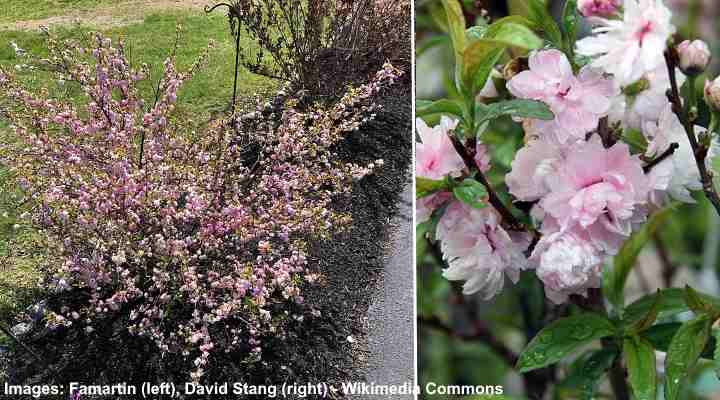
The Chinese plum tree is a decorative shrub-like tree known for its attractive clusters of fragrant, pinkish-white, spring-blooming flowers. Ideal for small gardens, this small tree showcases alternate, oval-shaped leaves that turn into beautiful hues of yellow and orange in autumn. The tree also produces round, dark red berries that create a beautiful contrast against the green foliage, enhancing its overall appeal.
Chinese plum trees are adaptable to a wide variety of soil types, as long as they are well-drained. This ornamental tree can be grown as a striking focal point, accent plant, or specimen plant in your small backyard. Incorporating it into your landscape design will greatly increase its overall beauty.
Growing conditions: Full sun to partial shade
Size: 4 to 5 ft. (1.2 – 1.5 m) tall and wide
Zones: 4 to 8
Yellow Oleander (Cascabela thevetia)
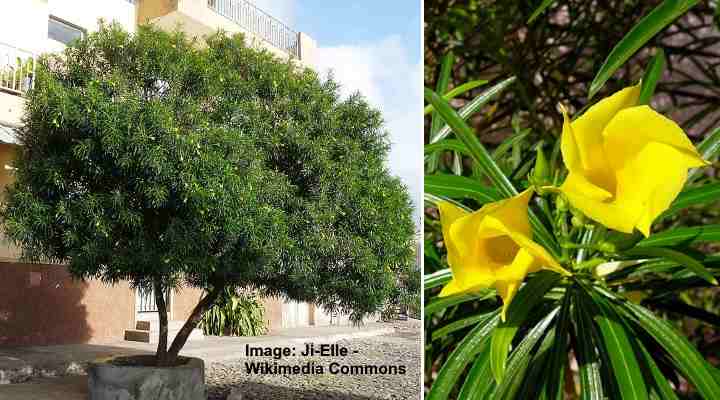
Suitable for a small-scale backyard, the yellow oleander is a dwarf yellow-flowering tree with shrub-like growth. The tree displays eye-catching, trumpet-shaped flowers in a vivid golden-yellow hue. These blooms are sparsely grouped at the tips of their branches. It also showcases willow-like, glossy green leaves that beautifully contrast against the golden yellow flowers. From late summer to autumn, the tree grows spherical green seed pods that transform into a red-black hue upon ripening, adding to its overall charm.
The yellow oleander grows best in moist, well-drained soil. This beautiful decorative tree is known for its ornamental features. However it’s essential to note that all parts of the tree are toxic, so exercise caution when planting around children or pets. Despite this, its vibrant, glossy green leaves and well-rounded canopy make it a great pick for decorative uses, adding an attractive centerpiece or accent to your landscape.
Growing conditions: Full sun to partial shade
Size: Up to 8 ft. (2.4 m) tall and 4 ft. (1.2 m) wide
Zones: 8 to 10
Weeping Scotch Laburnum (Laburnum alpinum ‘Pendulum’)
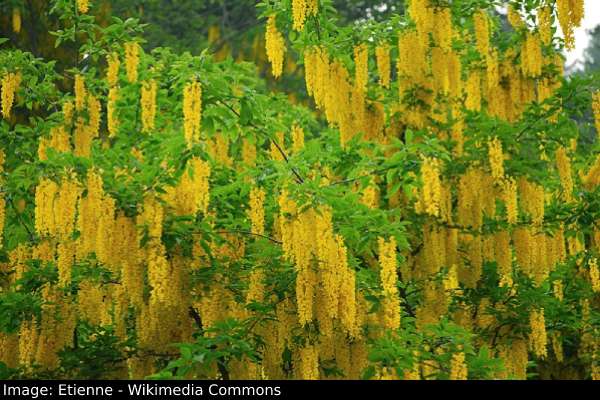
The weeping scotch laburnum makes a fantastic addition to a small backyard due to its compact size and fragrant, cascading yellow flowers. As an attractive decorative tree, it can be recognized by its umbrella-shaped canopy and pendulous, aromatic yellow flowers. Its lush, glossy green foliage also provides a beautiful backdrop against the bright yellow flowers.
The weeping scotch laburnum can be grown in any well-draining soil. This ornamental tree can serve as either a focal point or an accent plant in your small yard. Its weeping branches and small size also make it a good choice for tight spaces. The weeping scotch laburnum is guaranteed to elevate the appearance of your landscape with its graceful appearance and small, fragrant yellow flowers.
Growing conditions: Full sun or partial shade
Size: 6.5 to 8 ft. (2 – 2.5 m) tall and up to 6.5 ft. (2 m) wide
Zones: 5 to 7
Flame Azalea (Rhododendron calendulaceum)
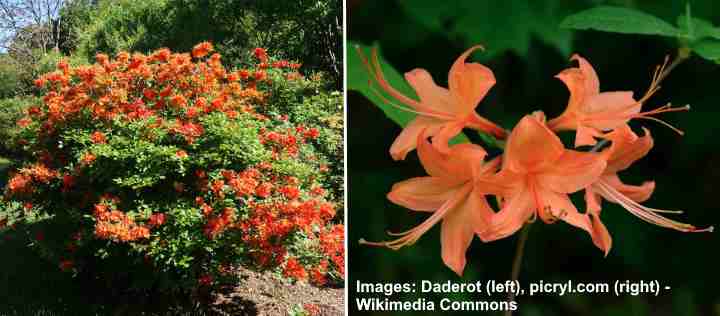
The flame azalea is a decorative, shrub-like tree with a compact growth habit, making it perfect for planting in small backyards. It is well-known for its bright orange to reddish-orange, attractive star-shaped flowers. The tree has mid-green, elliptic to ovate leaves with a soft hairy texture. During late autumn, the leaves undergo a striking transformation, shifting to either a vibrant red or a captivating yellow before they fall.
For optimal growth, plant the flame azalea in acidic, moist, well-drained soil in full sun. This appealing decorative tree is a great choice for use as a privacy screen, border plant, flowering hedge, or individual focal point. Including this tree in your backyard landscape is guaranteed to increase its overall beauty.
Growing conditions: Partial shade or full sun
Size: 4 to 8 ft. (1.2 – 2.4 m) tall and wide
Zones: 5 to 8
Waratah (Telopea speciosissima)
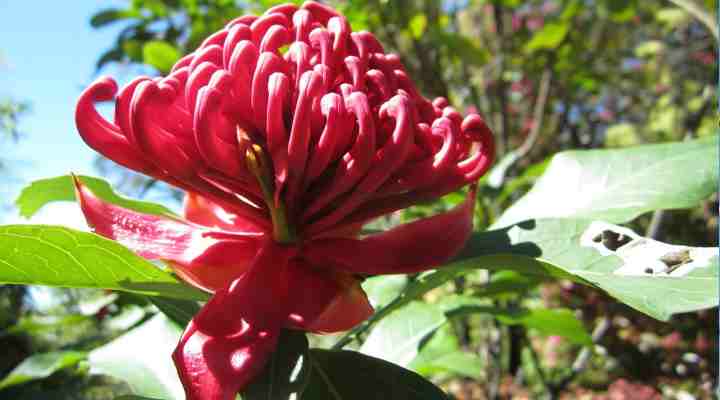
The waratah is a stunning, ornamental tree with a shrub-like growth habit. Renowned for its distinctive bright red flower heads that bloom during spring, the waratah is a beautiful addition to your small yard. At the foundation of the flower head, you’ll find prominent leafy bracts in hues of red, maroon, and pink. Additionally, the tree has dark green, glossy leaves with serrated edges, enhancing its overall appeal.
The waratah tree thrives when planted in well-drained soil. Due to their gradual growth and densely packed, compact canopy, these decorative trees serve exceptionally well as centerpieces in gardens, or as singular, standout trees. Their unique flower heads make them a fantastic choice for floral displays or cut flower arrangements.
Growing conditions: Full sun to partial shade
Size: 3 to 10 ft. (1 – 3 m) tall and wide
Zones: 8 to 10
Red Flowering Grevillea Trees
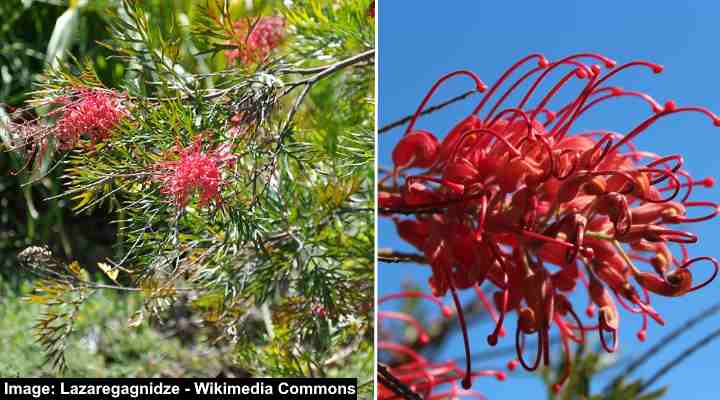
Red flowering grevilleas are perfect for planting in small backyards due to their compact size and beautiful red flowers. The red flowers have curled petals and protruding stamens, giving them a distinctive spider-like appearance. In addition, they also attract birds and bees with their fragrant smell, making them a perfect addition for a wildlife garden. This ornamental tree also features evergreen, fern-like leaves that are dark green in color.
Flowering grevilleas flourish in moist, acidic, well-drained soils. They are also incredibly versatile, capable of being used as excellent hedges, privacy screens, or individual specimen plants, adding a touch of charm to your landscape. Consider planting this tree in your small backyard due to its vibrant red blooms, compact size, and ornamental features.
Growing conditions: Full sun to partial shade
Size: 4 to 8 ft. (1.2 – 2.4 m) tall, depending on the species
Zones: 9 to 11
Common Lilac (Syringa vulgaris)
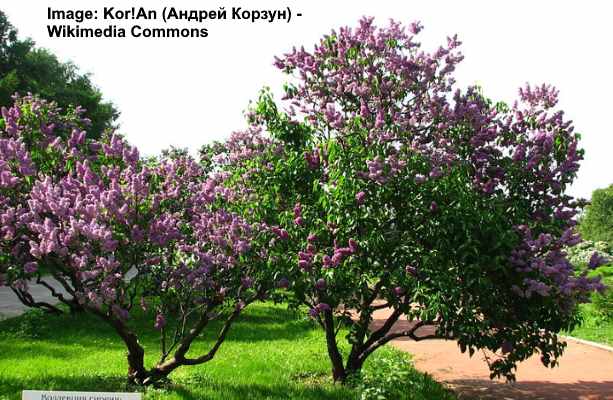
The common lilac is a great addition to a small backyard due to its compact, bushy form and fragrant pinkish-purple flowers. The flowers grow in beautiful cone-like clusters, usually blooming in late spring and lasting for a substantial 3-4 weeks. Its lilac blossoms also display charming shades of white, pink, or blue. Its smooth, heart-shaped leaves vary in color from bluish-green to dark green, adding a touch of decorative charm to its overall appearance.
Plant the common lilac in organically fertile, well-drained soil. It tolerates light shade but grows best in full sun. With its dense and attractive foliage, this shrub-like tree proves ideal for hedges, privacy screens, or even as a standalone tree. Growing this tree in your backyard will provide dependable spring blooms and a powerful fragrance that attracts bees and butterflies, adding beauty and elegance to your garden.
Growing conditions: Full sun for best flowering
Size: 8 to 10 ft. (2.4 – 3 m) tall and 5 to 6 ft. (1.5 – 1.8 m) wide
Zones: 3 to 8
Angel’s Trumpet (Brugmansia suaveolens)
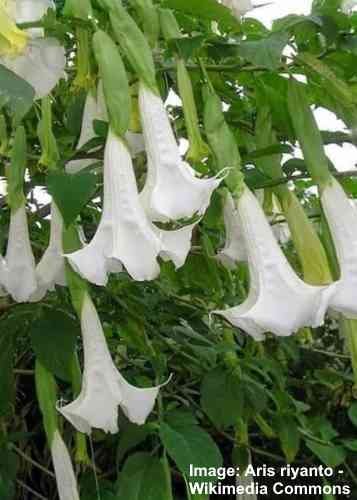
The angel’s trumpet is a small, semi-evergreen tree with a shrubby habit. Perfect in size for small gardens, it showcases large, hanging, trumpet-shaped flowers that are creamy-white in color. Its deep-green leaves are large, alternate, and usually covered with a thin layer of fine hairs. Over time, the tree forms a dense, vase-like canopy shape, with the branches spreading widely the more it grows.
The angel’s trumpet thrives when planted in full sun in moist, well-draining soil. Perfect for elevating garden beds and borders, this small ornamental tree effortlessly becomes a captivating centerpiece, while also adding a tropical touch to patios and decks. Keep in mind that the plant is toxic if consumed, so exercise caution when planting it in areas frequently visited by children or pets.
Growing conditions: Full sun or partial shade
Size: 3 to 8 ft. (1 – 2.4 m) tall and 2 to 4 ft. (0.6 – 1 m) wide
Zones: 9 to 11
Flowering Maple ‘Victor Reiter’ (Abutilon ‘Victor Reiter’)
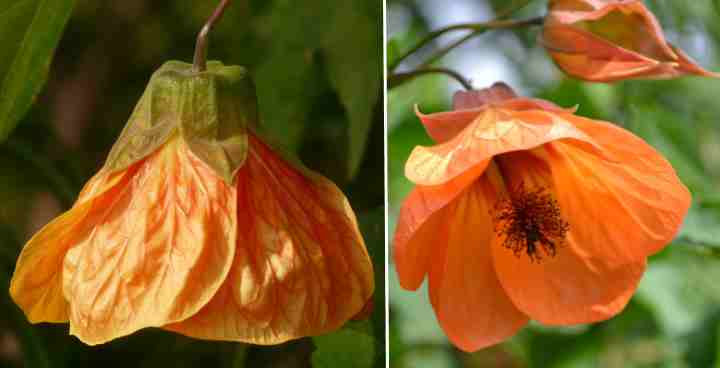
With its elegant, peach-colored, bell-shaped flowers and compact size, the flowering maple ‘Victor Reiter’ is an excellent ornamental addition to small backyards. These elegant flowers hang gracefully from the branches, while their yellow centers add a touch of visual interest to the tree’s appearance. This orange-flowering tree also has evergreen, maple-shaped dark-green leaves that create a beautiful contrast against the orange blooms.
‘Victor Reiter’ flowering maples grow best in well-draining soil that is moist, well-draining, and enriched with organic material. The bright orange blooms of ‘Victor Reiter’ flowering maples make them a superb choice to infuse small backyards, container gardens, or any landscape with a lively burst of color.
Growing conditions: Full sun to partial shade
Size: 6 to 8 ft. (1.8 – 2.4 m) tall and 4 ft. (1.2 m) wide
Zones: 9 to 11
Related articles:
